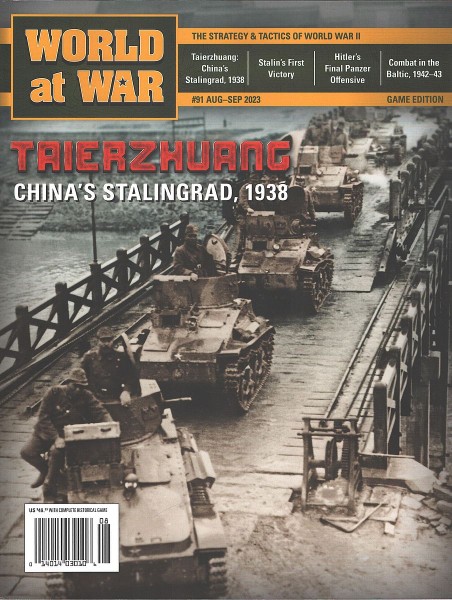inkl. MwSt. zzgl. Versandkosten
Sofort versandfertig, Lieferzeit ca. 1-3 Werktage
- Artikel-Nr.: SW15440
From Decision Games:
The Magazine:
The Battle of Taierzhuang: China’s Stalingrad, 1938 Early in 1938, despite the Tokyo government’s order for a Japanese defensive strategy in China that year, their generals decided on an offensive aimed at the rail hub city of Xuzhou and then on to Wuhan. The advance to Xuzhou would be supplied by the rail line that ran past the town of Taierzhuang.
Articles
-Stalin’s First Victory: The 1929 Sino-Soviet War On 27 April 1929, Chang Kai-shek sent troops to take over the Chinese Eastern Railway office in Mukden. That railroad was still run as a joint venture with the Soviets (who had inherited it from the czarist regime they overthrew in 1917). Before the end of the year, the Chinese and Soviets had fought their first war. It was a short but intensely contested affair in which Stalin barely squeezed out a victory.
-Hitler’s Final Panzer Offensive: On 4 April 1945, US 12th Army Group surrounded Germany’s Army Group B in the Ruhr. That cut off 370,000 soldiers, and it also split them into two pockets. One army was trapped in the Harz Mountains and three others were inside the Ruhr. Determined to restore a continuous front in the west, Hitler ordered a counterattack to free the army in the mountains and then advance farther to reopen the Ruhr encirclement.
-Combat in the Baltic, 1942–43 The northern sector of the east front did not move much during 1942–43, as it was anchored at besieged Leningrad. Even so, it remained active on the waters of the Baltic. The Soviet Navy had only two remaining bases during that period: Kronshtadt and Leningrad. Their surface vessels had to run a gauntlet of minefields and enemy aircraft to get into the Baltic. That meant weight of their offensive operations had to be assigned to their submarines.
The Game:
W91 Stalin’s First Victory (1929) & The Battle of Taierzhuang (1938) This game includes two separate and distinct battles. Both battles use many of the same rules and concepts, however for ease of play, the rules are separated into two distinct rule sets. The first set of rules cover Stalin’s First Victory and the second The Battle of Taierzhuang. Both games are low complexity two-player grand tactical games.
Stalin’s First Victory: Covers the five-day campaign between the Soviets and Chinese that determined the outcome of the 1929 Sino-Soviet War. Each hex on the map represents 1.25 miles or 2km. Each game turn represents one day. Units of maneuver are battalions, companies, and regiments.
The Battle of Taierzhuang: Covers the fighting that climaxed in the first (failed) Japanese offensive of 1938 in China. Each hex on the map represents .25 miles or .4km. Each game turn represents two days. Units of maneuver are Japanese infantry battalions and tank companies; and Chinese regiments.
22 x 34-inch game map with both battles; Stalin’s First Victory 48 5/8-inch counters; Taierzhuang 128 5/8-inch counters.
Präsentationsort im Laden: Ihr findet mich im Regal W8.
 Blitzkrieg 1939 - Hoeppner, 16th German Corps
Blitzkrieg 1939 - Hoeppner, 16th German Corps PO (Polish Rules), EN (English Rules as Download)
 Vae Victis Magazine #154 - Angola 1987 - 1988...
Vae Victis Magazine #154 - Angola 1987 - 1988... 









